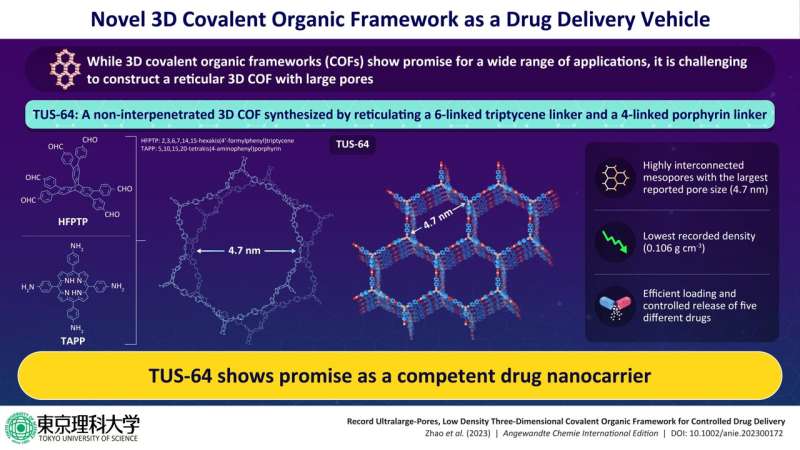This article has been reviewed according to Science X's editorial process and policies. Editors have highlighted the following attributes while ensuring the content's credibility:
fact-checked
peer-reviewed publication
trusted source
proofread
Towards a novel 3D covalent organic framework with record large pores for efficient drug delivery

Materials science is constantly evolving research area as researchers strive to discover and synthesize novel functional materials with desirable properties suited to a variety of applications. One example on this front is furnished by covalent organic frameworks (COFs), a class of materials characterized by crystalline porous polymers connected in the form of a network via covalent bonds.
Owing to their structural diversity, high porosity, and easily accessible active sites, COFs can be designed for a range of applications such as gas storage and separation, catalysis, and drug delivery. Despite such vast potential, however, most reported COFs suffer from small pore size due to the formation of interpenetrated frameworks during the construction process, which results in closely knit interwoven structures with restricted pore sizes.
Moreover, most research so far has focused on 2D COFs given the difficulty of constructing a 3D, non-interpenetrated COF with large pore sizes.
Now, in a new study published in Angewandte Chemie, researchers from Zhejiang Normal University, China and Tokyo University of Science (TUS), Japan have reported a novel 3D COF with the largest pore size and lowest density ever recorded.
The team, led by Professor Yuichi Negishi from TUS and including contributions from Dr. Saikat Das from TUS and Professor Teng Ben from Zhejiang Normal University, has achieved this feat by reticulating a 6-linked triptycene linker and a 4-linked porphyrin linker to form a non-interpenetrated network, resulting in the unprecedented pore size and density.
The material, which the team named TUS-64, was constructed by linking two specific building units: a 2,3,6,7,14,15-hexakis(4'-formylphenyl)-triptycene (HFPTP) as a 6-linked linker and a 5,10,15,20-tetrakis(4-aminophenyl)porphyrin (TAPP) as a 4-linked linker. The team used a method known as solvothermal condensation, which involved combining the two linkers in a solvent at a high pressure and temperature.
TUS-64 showed a honeycomb-like structure with a pore size of 4.7 nm, and a record low density of 0.106 g/cm3 (the density of water is 1 g/cm3). Despite its seemingly delicate structure, the material was shown to be resilient, withstanding decomposition in both organic and inorganic solvents, as well as temperatures up to 400°C.
The material's highly interconnected mesoporous structure along with its high stability make it ideal to hold and transport guest molecules. To explore the potential of TUS-64 as a drug delivery system, the team loaded five different drugs within the pores of the material and monitored their release in a phosphate buffer solution simulating human body fluid. The drugs included captopril (for hypertension and heart failure), ibuprofen (for fever and pain), isoniazid (for tuberculosis), 5-fluorouracil (for cancer), and brimonidine (for glaucoma).
In all instances, TUS-64 displayed a high capacity to hold the drugs along with a sustained release rate, making it suitable for delivering drugs over extended periods.
"TUS-64 shows all the desirable qualities of a drug delivery vehicle, such as controlled release kinetics, sustained delivery, and site-specific targeting," highlights Prof. Negishi, excited.
With TUS-64 as a potential game changer for many applications, new methods and techniques for developing 3D COFs with desirable characteristics—such as the one described in this study—could transform a wide range of industries and even people's lives.
"By making use of these characteristics of COFs, we could create new materials that will be required in the next generation society, such as drug delivery vehicles, energy and environmental materials, and separation materials," concludes Prof. Negishi.
More information: Yu Zhao et al, Record Ultralarge‐Pores, Low Density Three‐Dimensional Covalent Organic Framework for Controlled Drug Delivery**, Angewandte Chemie International Edition (2023). DOI: 10.1002/anie.202300172
Journal information: Angewandte Chemie International Edition , Angewandte Chemie
Provided by Tokyo University of Science





















